In south-eastern Mexico’s Yucatán state there’s a little town that practically gleams. Wandering through Izamal’s streets of yellow houses, it is possible to see evidence of the region’s pre-Hispanic and post-conquest history side by side with a laid-back and creative present-day society.
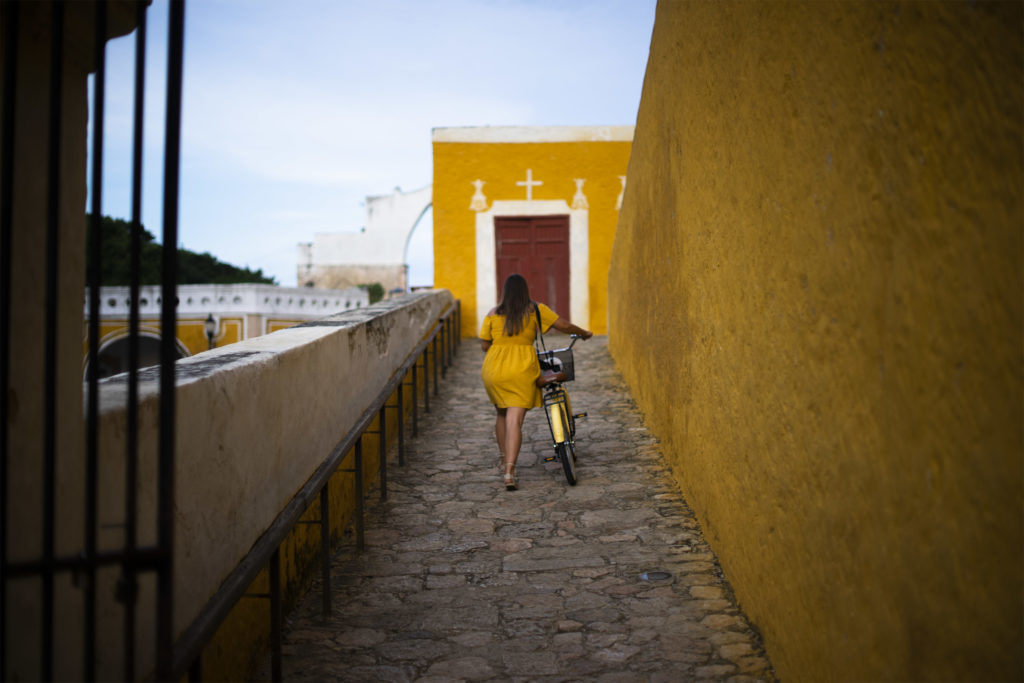
Exploring the yellow streets of Izamal (Photo: Roisin McAuley)
Taking its name from the Maya God Itzmal, the yellow town of Izamal is located an hour east of Yucatán’s main city, Mérida. A labyrinth of cobbled streets spill from the town’s two central squares, edged with an array of homes, businesses and workshops. These façades often lie with their windows and doors open, allowing passersby a glimpse of the locals’ daily life. An occasional motorbike splits the tranquillity of the otherwise sleepy streets, while horses decked out in colourful attire pull tourists along and locals peddle their bikes, or often tricycles, across the cobbles.
On the stairs of the central market, traders and locals pass hours chattering and enjoying the shade created by the roof of the marketplace. Yucatán is hot all year round with very little respite on offer, though locals of the area feel the small drop in temperature that arrives from late October through to January.
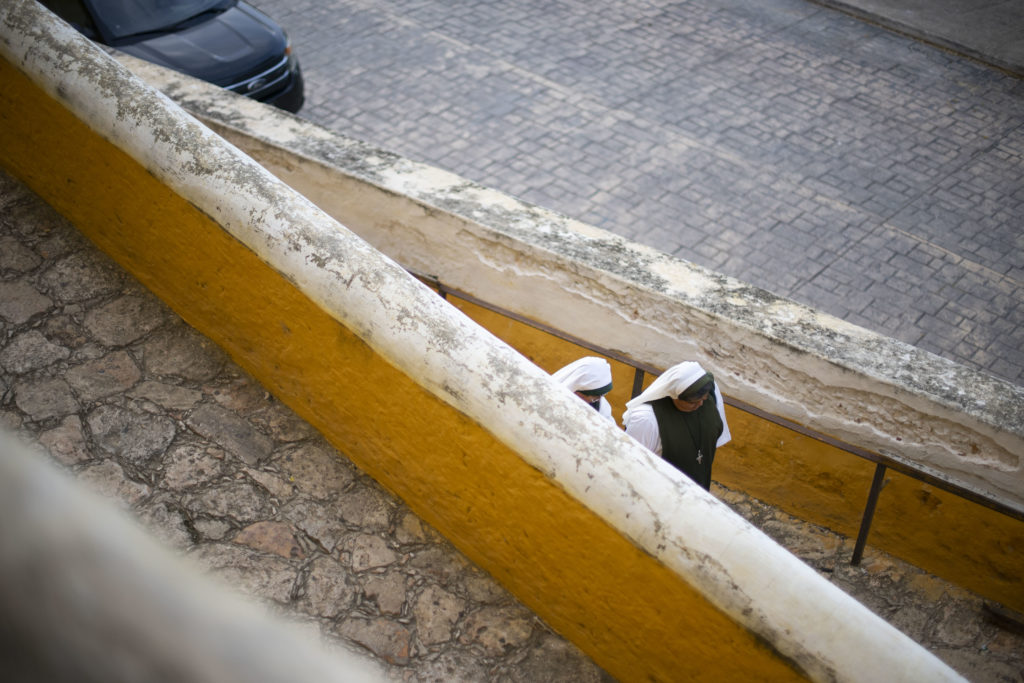
Nuns walking up to the convent (Photo: Roisin McAuley)
On arrival in Izamal there’s often one obvious question: why is the town painted yellow? A variety of rumours circulate masquerading as the truth. The most common being that the city was painted yellow to celebrate the visit of Pope John Paul II in August 1993. Although the date of the city’s drenching in yellow and the Pope’s visit are very close, locals and guides will be quick to tell you that this is a complete myth.
The other explanation is that in the early 1990s, locals of the town decided it was in need of a revamp and wanted to create uniformity, so they elected to paint the town centre yellow: a colour that was not aligned to either of the country’s main political parties at the time, that repelled mosquitoes and would get rid of any posters and marketing that were commercializing the centre.
Pueblo Magico
All the cultures that have occupied or passed through Izamal throughout its long history have left their mark on its creative canvas. Known as ‘the city of three cultures,’ there’s an architectural and cultural fusion of the ancient Maya, the colonial Spanish, and present-day Mexican sensibilities. Like much of the culture found elsewhere in the Yucatán, it is unique, differing from what you’ll find elsewhere in Mexico, partly because the region remained isolated from the rest of the country until the mid-20th century.
Partly due to this, Izamal received the title of Pueblo Magico, or Magic Town, in 2002. The Pueblo Magico programme is an initiative from the Mexican tourist board to recognise towns and villages that excel in offering visitors natural beauty, cultural richness, traditions, folklore, historical relevance, cuisine, arts & crafts, and great hospitality. Izamal is one of two such locations in Yucatán, the other being the larger city of Valladolid, which is an hour east of Izamal.
Things to Do
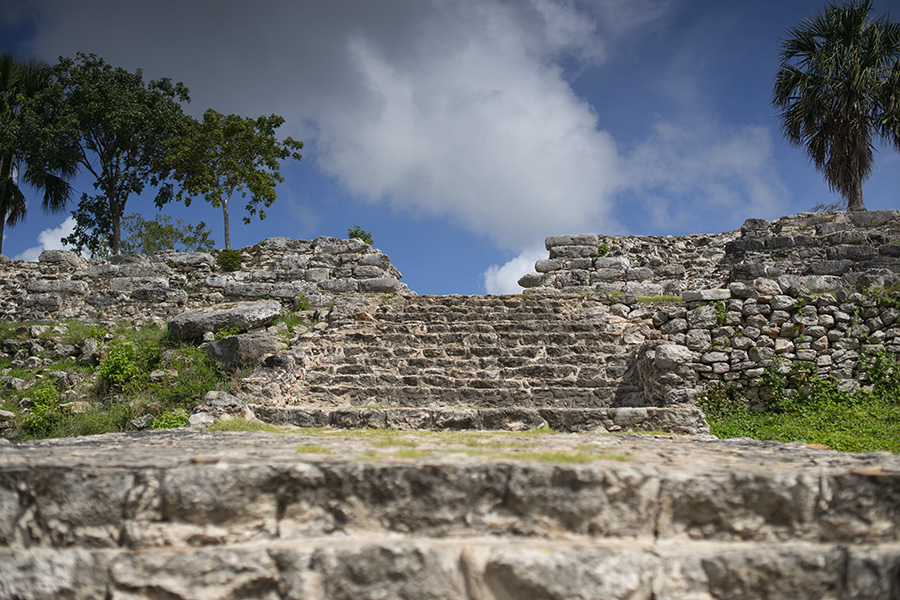
The pre-Hispanic steps of Kinich are a challenge to climb (Photo: Roisin McAuley)
Izamal easily ticks a number of the boxes required for a Pueblo Magico. Archaeological Maya sites crop up throughout the city but the most prominent is the Kinich Kakmó pyramid. This pyramid is lesser-known than Yucatán’s Chichén Itzá, which is recognised as one of the seven wonders of the new world, but unlike Chichén Itzá you are able to climb Kinich Kakmó. This pyramid was constructed to honour the God of the same name, with its name translating to “Sun-Eyed Fire Macaw”, as historians believe the god Kinich transformed into a macaw to purify the sacrifices or offerings brought by the Maya.
There were 12 Maya pyramids originally in Izamal, and whilst some have been restored others are smaller ruins. As well as the Kinich Kakmó, other historical sites of interest include the archaeological site and pyramid of Habuk and the base of the El Cenejo or Tu’Ul, the rabbit, pyramid.
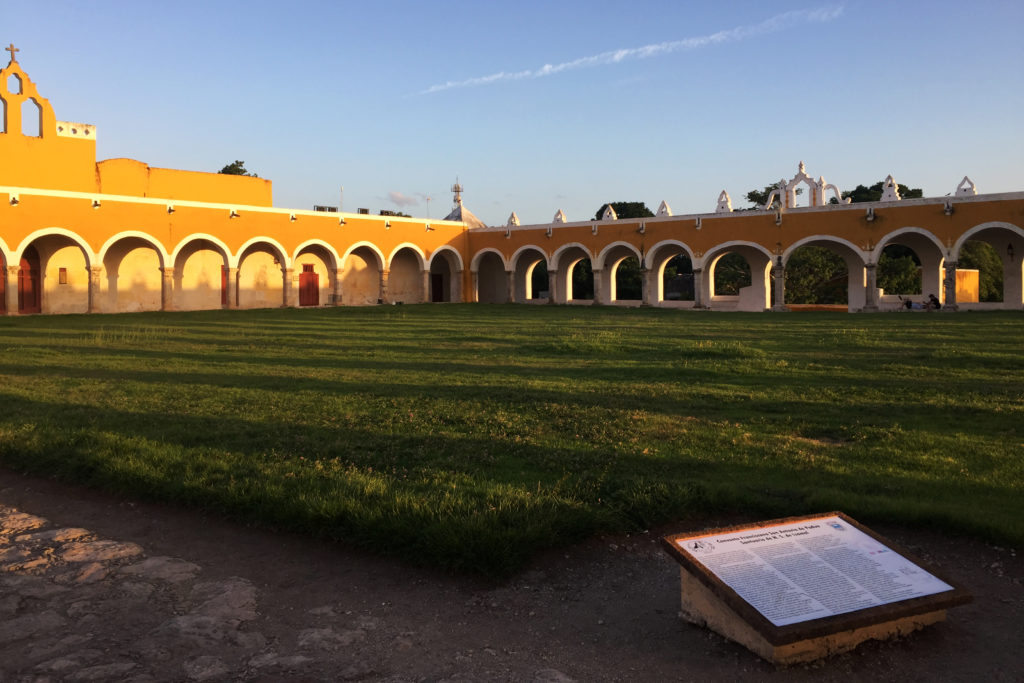
The courtyard of the Convento San Antonio de Padua (Photo: Roisin McAuley)
Perhaps the most recognisable symbol of the town is the yellow Convento San Antonio de Padua. The convent was founded in 1549 by Father Fray Diego de Landa and other Franciscan missionaries after the Spanish arrived to conquer Izamal and found it had been abandoned by locals who fled prior to their arrival. The conquerors then destroyed the Maya pyramid of Pap Hol Chac and built the convent on top of its ruins, using the pyramid stones to construct the convent’s façade.
Today, a small ascent leads visitors to the vast courtyard of the convent. Nuns amble through its grassy grounds in the direction of the chapel, whilst school children and youngsters hang out in the arches which line the its perimeter. From here, much of the town can be seen as few things in Izamal, and Yucatán in general, are high in stature.
The Centro Cultural y Artesanal de Izamal, or Cultural and Craft Center of Izamal, is located in one of the town’s main squares. The compact museum showcases traditional crafts from across Mexico, with each room filled with artefacts created by traditional techniques that are becoming less and less common in modern times. The exhibition is part of a cultural development project that aims to both celebrate and resurrect these crafts.
At the museum, you can pick up a guide to the local workshops, or tallers, and head off on the local workshop trail to discover artisans that are particularly important to Izamal. This features a combination of jewellers, embroiderers and herbalists, to name just a few.
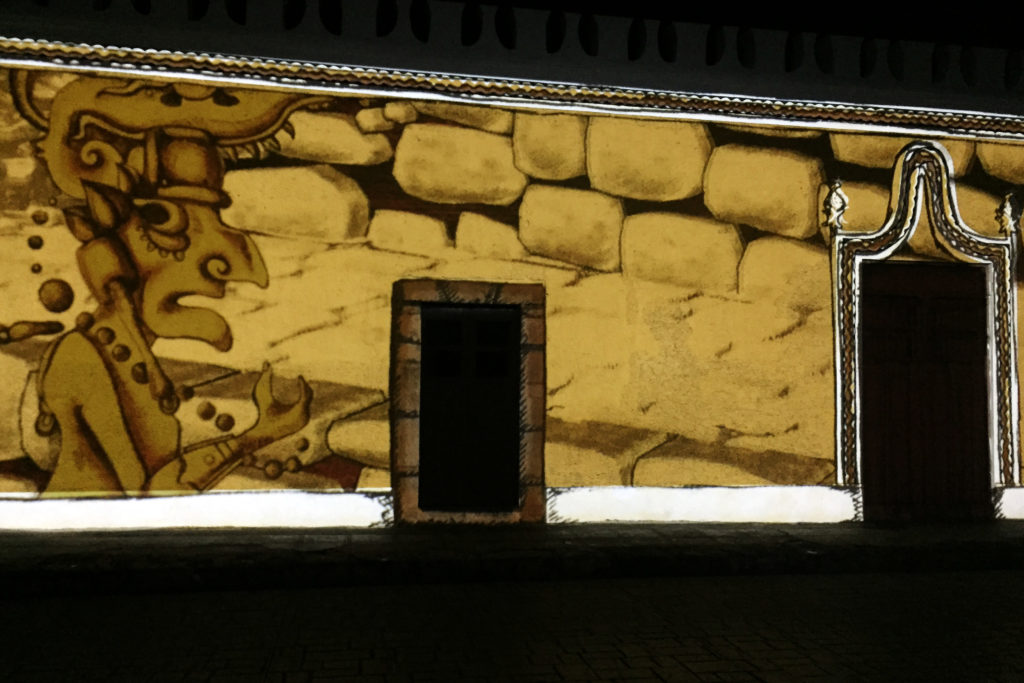
Animations decorate a building during Izamal’s sound and light show (Photo: Roisin McAuley)
Combing the history and creativity of the city the ‘Light of the Maya’ Sound and Light Show takes place at 8 pm on Thursdays, Fridays and Saturdays departing from the Parque de Los Cañones, just west of the centre of the town. Weather-permitting, this light show decorates buildings and doorways with illustrations depicting the city’s origins accompanied by a narrative of the city’s history and led by the local guide.
The classic town bikes are another symbol of Izamal, and tourists to the city can rent bikes to explore the town at Izamal Bikes and Crafts (Calle 32 #299). Given its small size, this is an enjoyable and convenient way to discover every corner of the town within a few hours. The fact that everything is yellow, flat and on a one-way system adds to the challenge of navigating the city and visitors are bound to get lost, but locals are often happy to help with directions.
Where to stay
For visitors who aren’t in a rush to leave the city and wish to explore it at their own pace, there are a number of hotels in town. Hotel San Miguel Arcangel (Calle 31-A #310A) is located centrally in one of Izamal’s main squares. This beautiful, homely hotel welcomes guests with its intimate courtyard built amongst the ancient ruins of a pyramid dedicated to Hun-Pic-Tok, the Maya God of War. Rooms are air-conditioned to ensure guests are comfortable in Yucatán’s tropical climate. The hotel’s convenient location means that guests have both the local market and the convent on their doorstep.
Hotel Casa Colonial (Calle 31 #331) offers bed and breakfast style accommodation at a lovely old colonial house near the town centre. Amenities at this hotel ensure guests can enjoy a little more than just the essentials, including an outdoor pool, relaxing garden space and free bikes to explore the town with.
Just outside of the centre of the town the EcoHotel Spa Boutique Itzamaltun (Calle 31 #251) offers a little bit of luxury. The spa has a range of massage and aromatherapy treatments, as well as an outdoor swimming pool and garden terrace to relax and enjoy a drink in. The hotel’s restaurant has traditional flavours from both Yucatán and Mexico on its menu, and rooms are air-conditioned with their own private terraces.
Restaurants & Cafés
Yucatán is famous for its gastronomy and Izamal offers up many traditional flavours. In one of the town’s squares, local vendors can be found selling local street food and passing the time of day. A popular dish to enjoy from these stalls is a sweet and savoury marquesita: crispy crepes, covered in your choice of filling and rolled into a long cone. The popular flavour of Nutella and cheese might be a little surprising but it’s worth trying.
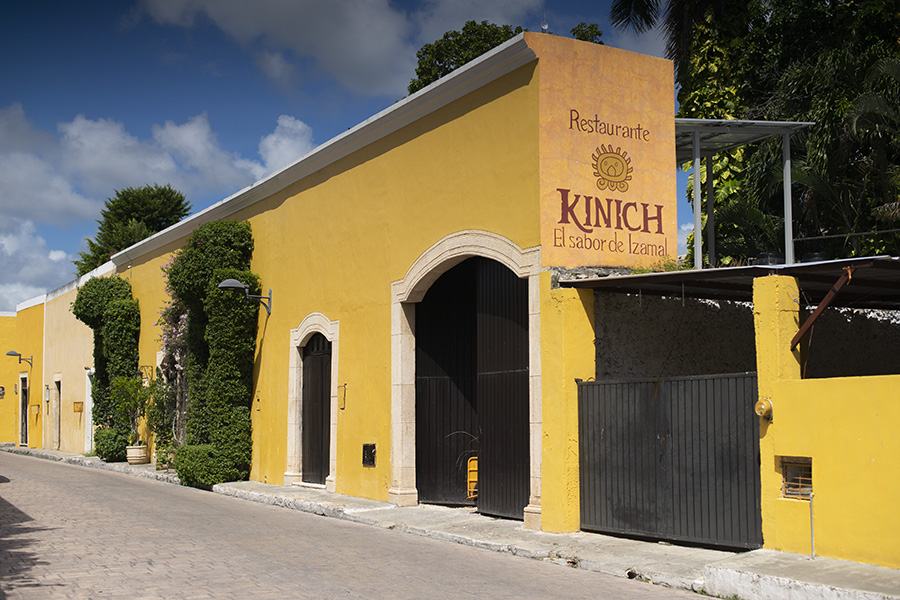
Restaurant Kinich is a great stop to try traditional Yucatecan flavours (Photo: Roisin McAuley)
Perhaps Izamal’s most famous restaurant, Kinich (Calle 27 #299) takes its name from the pyramid that it neighbours. For this reason, expect to find lots of tourists here, but don’t worry it’s not a tourist trap. Kinich has a lot to offer: a beautiful dining setting, attentive staff, great ambience and, of course, traditional Yucatecan flavours. Dishes are made from locally sourced ingredients, made freshly to order and, typical across Mexico, in generous portion sizes.
For a quick breakfast or lunch in the centre of town, the cafe of Hotel San Miguel Arcangel (Calle 31-A #310A) serves dishes traditional to Yucatán and the rest of Mexico, as well as the odd European option. As well as the food, agua frescas, traditional waters flavoured with different fruits, herbs or spices such as chaya or hibiscus, can be enjoyed in the main courtyard-style cafe.
Local restaurant Cafe Los Arcos (Calle 28 #296) is located in one of the town’s main squares. The restaurant offers indoor seating, an intimate patio/terrace and seating on the street front for those who want to watch life in Izamal pass them by. Los Arcos is open throughout the day, with breakfast options, small snacks and various veggie-friendly meals as well as classic dishes making it an easy choice for any time of day. Unlike many of the town’s larger restaurants that are packed with tourists, like Kinich and Zamna, Los Arcos enjoys a more of a local vibe and serves food until 10 pm.

The traditional surroundings of Zamna (Photo: Roisin McAuley)
Located on the way into Izamal, Zamna (Calle 31 #336) creates a traditional atmosphere that complements the ancestral flavours of its menu. Papadzules, lime soup, stuffed cheese, conchinita pibil, poc chuc, all the state’s classic dishes, are served here with complimentary crisp tortillas accompanied by spicy dips, refried beans and salsas.
A little further out of the centre, Restaurante La Conquista (Calle 30 #219) is a cosy dining option, similar in style to Kinich but lesser-known so expect less tourists and more local diners. The generous portion sizes mean visitors might struggle to fit in something sweet, but both the flan and dulce papaya, are worth saving some room for.